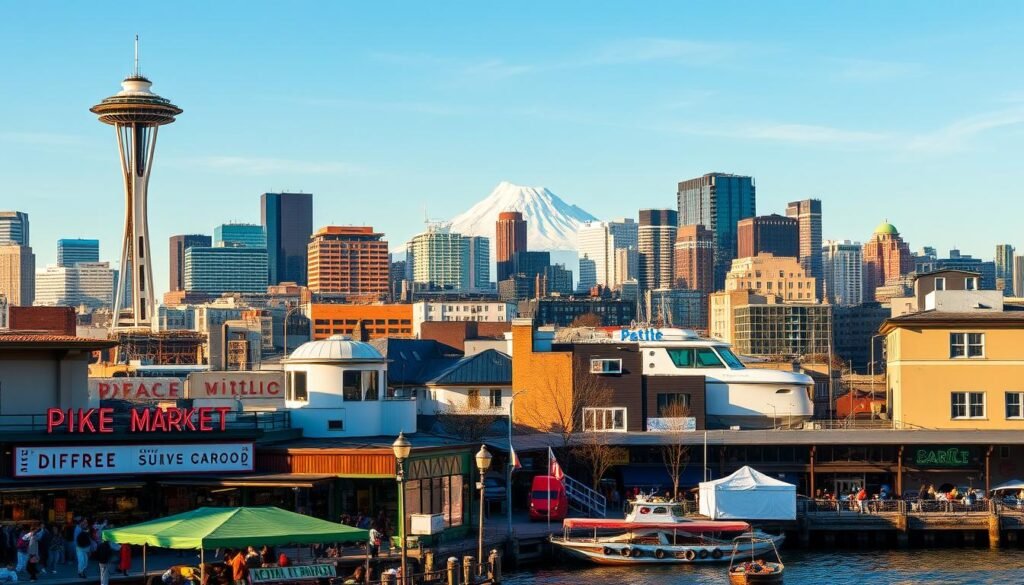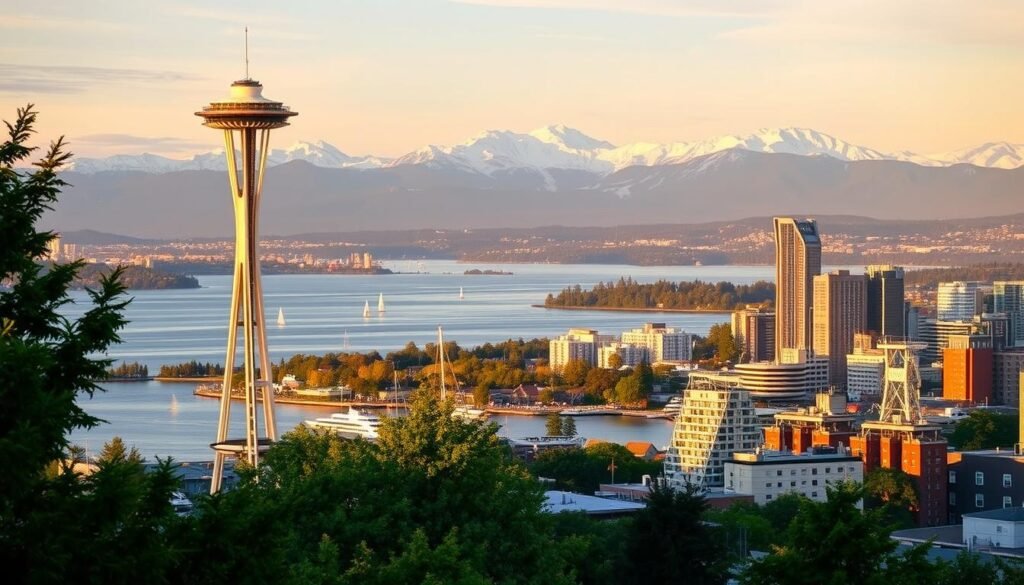Did you know Seattle once had 55 straight dry days in 2017? That streak shows this Pacific Northwest city can surprise you. I use that fact to rethink when I plan my next trip.
I focus on three things: daylight, weather, and crowds. Summers bring warm, 75°F (24°C) days and long light—perfect for the Space Needle and Pike Place Market, but prices rise and visitors swell.
Spring fills parks with cherry blossoms and the Skagit Valley Tulip Festival. Fall cools into mild mid-40s°F to mid-60s°F (7–16°C) with fewer crowds and lively events like Earshot Jazz.
Winters are wetter and chillier, near 45°F (7°C), yet hotel rates drop and cozy indoor spots like the Museum of Pop Culture shine. For a practical planning tip, see this short guide from Lonely Planet for calendar-minded travelers.
Key Takeaways
- Summer = long days, warm weather, higher prices and crowds.
- Spring = blooms and festivals with pleasant walking weather.
- Fall = mild temps, fewer people, cultural events.
- Winter = lowest rates and cozy indoor options.
- I recommend choosing the season that fits your pace—active sightseeing or a quiet escape.
How I Decide When to Visit: Weather, Crowds, Prices, and Events
Choosing when I go hinges on four simple things: forecast, foot traffic, cost, and what’s happening around town.
Seattle weather decoded: rainy days, clear summer skies, and comfortable temperatures
I start with the forecast. Summers (June–September) are the driest months; July averages about 1.2 inches of rain, and the city even saw 55 consecutive dry days in 2017.
Typical summer highs sit near 75°F (24°C) with long daylight. Spring and fall usually land in the 50s–60s°F and bring light drizzle more than heavy downpours. Winters hover around 45–47°F (7–8°C), which is great for indoor museums and lower prices.
Balancing crowds and budget: low season perks vs peak season buzz
I weigh crowds against prices. Peak months carry energy and events but higher rates. Shoulder months like April offer fewer people and better hotel deals while still giving decent weather.
Daylight and outdoor activities in the Pacific Northwest
Daylight drives my outdoor plans. Long summer days make it easy to fit in hikes, ferries, and markets. If outdoor activities are my main goal, I aim for clearer months.
- I pack for drizzle—waterproof layers rather than heavy gear.
- I check the temperatures range for evenings because sea breezes cool things quickly.
- I plan driving through the city between 9am–4:30pm or after 7pm to avoid rush-hour delays.
Best Time to Visit Seattle: My Top Picks by Interest and Budget

My ideal visit starts with one clear goal—sunshine, blooms, culture, or savings—and I build from there. Below are compact windows I choose depending on what I want from the city.You can learn more about best-places-to-visit-in-november.
For sunshine and iconic views
I aim for June–September when long daylight and clearer skies make the Space Needle and waterfront especially photogenic. I try sunrise or sunset at the tower to beat lines and capture both day and night vistas.
For blossoms and shoulder-season savings
April gives me cherry blossom moments at the seattle cherry festival and day trips to the tulip festival. Hotels are friendlier on price, so a nicer room feels attainable.
For culture, music, and festivals
Late summer into fall is when I book Bumbershoot around Labor Day, enjoy Earshot Jazz nights, and sip Oktoberfest steins as visitor counts drop and hotel rates ease.
For the lowest prices and cozy indoor life
Winter is my pick for rock-bottom lodging and coffee-led wandering. Museums and music venues keep the city lively while crowds thin in the low season.You can learn more about best-places-to-visit-in-colorado
For whale watching, sports, and fewer crowds
Post-Labor Day to early October blends lingering sun, prime whale watching, and lighter crowds at stadiums and markets. I balance one bucket-list day with flexible plans so the city can surprise me.
Season-by-Season Guide to Seattle
I map the year by seasons so I know when festivals, foliage, and fair weather line up. This quick guide helps me match activities with likely temperatures, crowd levels, and hotel costs.
Spring (March–May)
Spring brings cherry blossom displays and the Skagit Valley Tulip Festival, usually peaking in April.
Average highs sit in the 50s–60s°F, and wind can make it feel cooler, so I layer up.You can learn more about best-time-to-visit-grand-canyon.
Summer (June–August)
Summer is the driest stretch: July averages about 1.2 inches of rain and highs near 75°F (24°C).
I book Pride and Seafair events early and plan Space Needle visits at sunrise or sunset to avoid the biggest crowds.
Fall (September–November)
Fall serves lingering sun through early October, colorful foliage, and festivals like Bumbershoot.
Hotel prices drop after Labor Day, but rain rises by November—perfect for coffee shops and indoor music nights.
Winter (December–February)
Winter is the rainiest stretch, with temps around 45–47°F (7–8°C). I use this low season for lower hotel rates and holiday events like Winterfest.
Quick trips to the Cascades make skiing or snowboarding an easy add-on.
Shoulder-season sweet spots
April and September–early October strike a good balance of weather, lighter crowds, and friendlier prices.You can learn more about best-places-to-visit.
Getting around and timing your day
I avoid rush hours by driving between 9am–4:30pm or after 7pm.
That schedule gives me more hours for outdoor activities and fewer minutes stuck in traffic.
| Season | Typical temps | Highlights | Practical tip |
|---|---|---|---|
| Spring | 50s–60s°F | Cherry blossom, tulip festival | Pack layers; check forecasts |
| Summer | ~75°F | Pride, Seafair, long daylight | Book events and Space Needle slots early |
| Fall | 50s–60s°F early | Foliage, Bumbershoot, Oktoberfest | Aim for early October for clearer days |
For a month-by-month look at average conditions across the year, I use an average weather by month chart before I finalize dates.
Conclusion
The simple rule I use: pair your must-do activities with the season that supports them and this guide will help you find the perfect time for your plan. Match culture choices and outdoor pursuits, then pick dates that fit your pace.
Clear summer skies and long days favor the Space Needle and major events. April and post-Labor Day through early October balance weather, crowds, and value for spring blooms and fall festivals.
Winter brings lower hotel rates, coffee-led afternoons, and festive lights despite the rain. Fewer visitors mean slower city rhythm and room in the budget for cozy culture and short Cascade trips.
Make a short list of must-do items, then slot them into the right season this year. Do that and you’ll have a great time on your trip in the united states — a practical, simple guide to planning your visit without stress.





















